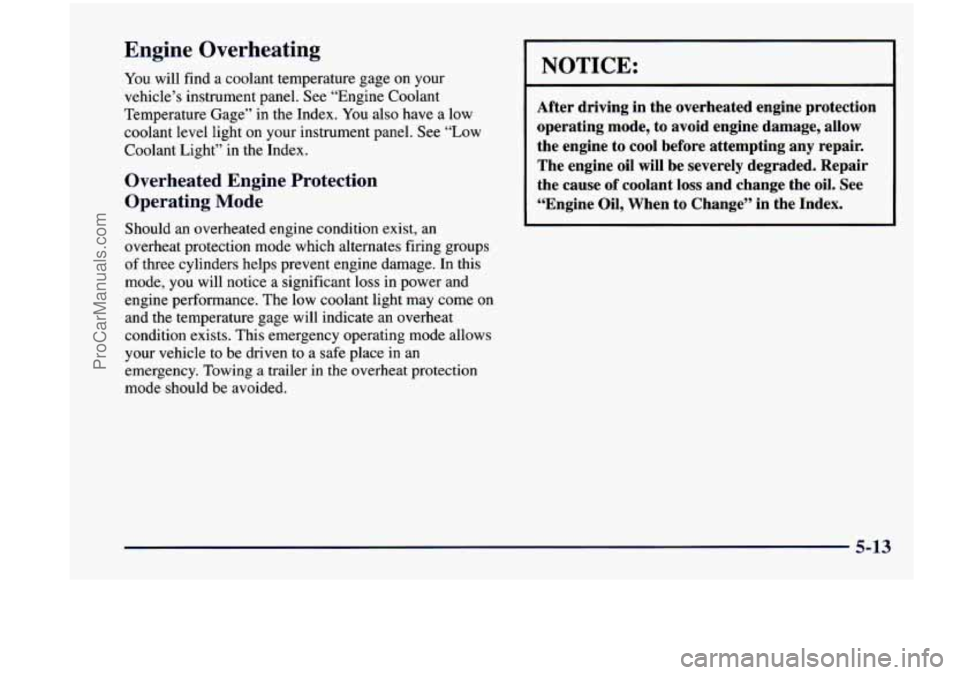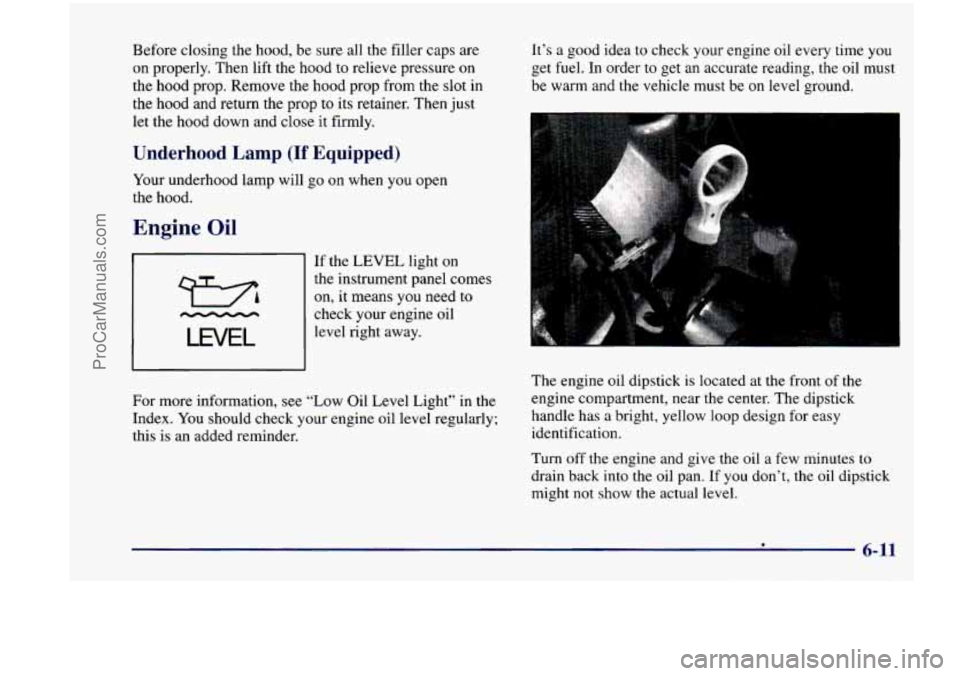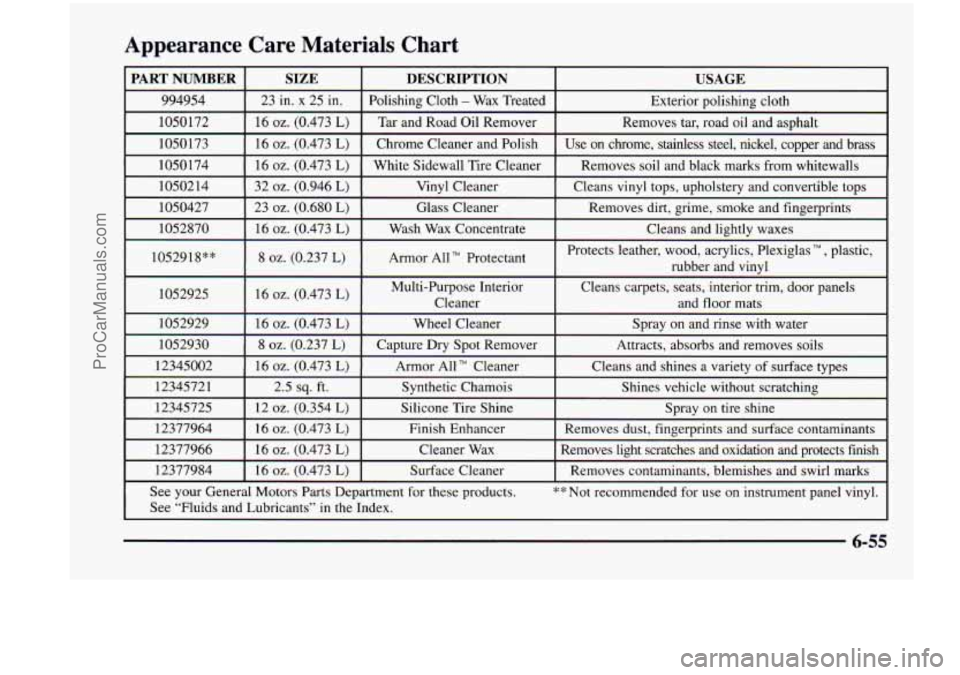1998 CHEVROLET VENTURE instrument panel
[x] Cancel search: instrument panelPage 310 of 474

Engine Overheating
You will find a coolant temperature gage on your
vehicle’s instrument panel.
See “Engine Coolant
Temperature Gage” in the Index.
You also have a low
coolant level light on your instrument panel. See “Low
Coolant Light’’ in the Index.
Overheated Engine Protection
Operating
Mode
Should an overheated engine condition exist, an
overheat protection mode which alternates firing groups
of three cylinders helps prevent engine damage. In this
mode, you will notice a significant loss in power and
engine performance. The low coolant light may come
on
and the temperature gage will indicate an overheat
condition exists. This emergency operating mode allows
your vehicle to be driven to a safe place in an
emergency. Towing
a trailer in the overheat protection
mode should be avoided.
NOTICE:
I
After driving in the overheated engine protection
operating mode, to avoid engine damage, allow
the engine to cool before attempting any repair.
The engine oil will be severely degraded. Repair
the cause of coolant loss and change the
oil. See
“Engine Oil, When
to Change” in the Index.
5-13
ProCarManuals.com
Page 339 of 474

If your vehicle is certified to meet California Emission
Standards (indicated on the underhood emission control
label),
it is designed to operate on fuels that meet
California specifications. If such fuels are not available
in states adopting California emissions standards, your
vehicle will operate satisfactorily on fuels meeting
federal specifications, but emission control system
performance may be affected. The malfunction indicator
lamp on your instrument panel may turn on and/or your
vehicle may fail a smog-check test. If
this occurs, return
to your authorized Chevrolet dealer for diagnosis to
determine the cause of failure. In the event it is
determined that the cause of the condition is the type
of
fuels used, repairs may not be covered by your warranty.
Some gasolines that are not reformulated for low
emissions contain an octane-enhancing additive called
methylcyclopentadienyl manganese tricarbonyl
(MMT);
ask your service station operator whether or not his fuel
contains MMT. General Motors does not recommend the
use of such gasolines. If fuels containing
MMT are used,
spark plug life may be reduced and your emission
control system performance may be affected. The
malfunction indicator lamp on your instrument panel
may turn on.
If this occurs, return to your authorized
Chevrolet dealer for service.
To provide cleaner air, all gasolines in the United States
are now required to contain additives that will help
prevent deposits from forming in your engine and fuel
system, allowing your emission control system to
function properly. Therefore, you should not have to
add anything to the fuel. In addition, gasolines
containing oxygenates, such as ethers and ethanol, and
reformulated gasolines may be available in your area to
help clean the air. General Motors recommends that you
use these gasolines
if they comply with the
specifications described earlier.
NOTICE:
Your vehicle was not designed for fuel that
contains methanol. Don’t use it. It can corrode
metal parts in your fuel system and also damage
plastic and rubber parts. That damage wouldn’t
be covered under your warranty.
6-4
ProCarManuals.com
Page 346 of 474

Before closing the hood, be sure all the filler caps are
on properly. Then lift the hood to relieve pressure on
the hood prop. Remove the hood prop from the slot in
the hood and return the prop
to its retainer. Then just
let the hood down and close it firmly.
Underhood Lamp (If Equipped)
Your underhood lamp will go on when you open
the hood.
Engine Oil
If the LEVEL light on
the instrument panel comes on, it means you need
to
level right away.
hhhhhh
LWEL
check your engine oil
For more information, see “LOW Oil Level Light” in the
Index. You should check your engine oil level regularly:
this
is an added reminder. It’s a good idea to check your engine oil every time
you
get
fuel. In order to get an accurate reading, the oil must
be warm and the vehicle must be on level ground.
The engine oil dipstick
is located at the front of the
engine compartment, near the center. The dipstick
handle has a bright, yellow loop design for easy
identification.
Turn off the engine and give the oil a few minutes
to
drain back into the oil pan. If you don’t, the oil dipstick
might not show
the actual level.
a 6-11
ProCarManuals.com
Page 385 of 474

Cleaning Vinyl
Use warm water and a clean cloth.
Rub with a clean, damp cloth to remove dirt. You
may have to
do it more than once.
Things like tar, asphalt and shoe polish will stain if
you don’t get them off quickly. Use a clean
cloth and a vinyVleather cleaner.
See your dealer
for this product.
Cleaning the Top of the Instrument Panel
Use only mild soap and water to clean the top surfaces
of the instrument panel. Sprays containing silicones or
waxes may cause annoying reflections in the windshield
and even make it difficult to see through the windshield
under certain conditions.
Cleaning Interior Plastic Components
Use only a mild soap and water solution on a soft
cloth or sponge. Commercial cleaners may affect the
surface finish.
Cleaning the Built-in Child
Restraint Pad
The built-in child restraint pad is attached to the seat
frame with fastener strips.
You can remove the pad and
hand wash
it with mild soap and water.
Care of Safety Belts and Built-in Child Restraint Harness
Keep the safety belts and the built-in child restraint
harness clean and dry.
U
Do not bleach or dye safety belts or the built-in
child restraint harness.
If you do, they may be
severely weakened. In a crash, they might not be
able to provide adequate protection. Clean the
safety belts and the child restraint harness only
with mild
soap and lukewarm water.
6-50
ProCarManuals.com
Page 390 of 474

Appearance Care Materials Chart
PART NUMBER I SIZE
994954 I 23 in. x 25 in.
1050172 I 16 02. (0.473 L)
~~~~ ~~
1050173 16
oz. (0.473 L) 1052870 23
oz. (0.680 L) 1050427 32
oz. (0.946 L) 1050214
16
oz. (0.473 L) 1050174 16
02. (0.473 L)
DESCRIPTION
Exterior
polishing cloth
Polishing Cloth - Wax
Treated
USAGE
Tar and Road Oil Remover
Use on chrome, stainless steel, nickel, copper and brass
Chrome Cleaner and Polish Removes
tar, road oil and asphalt
Removes soil and black marks from whitewalls
White Sidewall Tire Cleaner
Vinyl Cleaner
Glass Cleaner Cleans vinyl tops,
upholstery and convertible tops
Removes dirt, grime, smoke and fingerprints
Wash Wax Concentrate Cleans and lightly waxes
1052918”” I 8 oz. (0.237 L) Armor All Protectant Protects
leather, wood, acrylics, Plexiglas TM , plastic,
rubber and vinyl
1052925 I 16 oz. (0.473 L) I
Multi-Purpose Interior
Cleans carpets, seats, interior trim, door panels
Cleaner and
floor mats I
1052929 I 16 oz. (0.473 L) I Wheel Cleaner I Spray on and rinse with water
1052930
Spray on tire shine
Silicone Tire Shine 12 02. (0.354 L) 12345725
Shines
vehicle without scratching
Synthetic Chamois 2.5 sq. ft. 12345721
Cleans and
shines a variety of surface types
Armor
All TM Cleaner 16 oz. (0.473 L) 12345002
Attracts, absorbs and removes soils Capture Dry Spot Remover 8 oz. (0.237 L)
12377964
See your General Motors Parts Department for these products. ** Not recommended for use on instrument panel vinyl.
Removes contaminants, blemishes
and swirl marks
Surface Cleaner
16 oz. (0.473 L) 12377984
Removes light scratches and oxidation and protects finish
Cleaner
Wax 16 02. (0.473 L) 12377966
Removes dust, fingerprints and surface contaminants
Finish
Enhancer 16 02. (0.473 L)
See “Fluids and Lubricants’’ in the Index.
6-55
ProCarManuals.com
Page 391 of 474

Vehicle Identification Number (VIN) Service Parts Identification Label
You’ll
find this label on the inside of the access panel
located on the driver’s side
of the rear of the vehicle.
It’s very helpful if you ever need to order
parts. On
0 your VIN,
rn Am A this label is:
ENGINEAk + 1 ASSEMBLY
CODE MODEL YEAR PLANT 0 the model designation,
0 paint information and
This is the legal identifier for your vehicle. It appears on
a plate in the front corner of the instrument panel, on the
driver’s side.
You can see it if you look through the
windshield from outside your vehicle. The
VIN also
appears on the Vehicle Certification and Service
Parts
labels and the certificates of title and registration.
Engine Identification
The 8th character in your VIN is the engine code. This
code will help you identify your engine, specifications
and replacement
parts.
a list of all production options and
special equipment.
Be sure that this label is not removed from the vehicle.
6-56
ProCarManuals.com
Page 393 of 474

Fuses and Circuit Breakers
The wiring circuits in your vehicle are protected from
short circuits by a combination of fuses, circuit breakers
and fusible thermal links.
Look at the silver-colored band inside the fuse. If
the
band is broken or melted, replace the fuse. Be sure you
replace a bad fuse with a new one of the identical size
and rating.
If you ever have a problem on the road and don’t have
a spare fuse, you can borrow one that has the same
amperage or use one of the spare fuses in the underhood
fuse and relay center. Just pick some feature of your
vehicle that you can get along without
-- like the radio
or cigarette lighter -- and use its fuse, if it is the right
amperage. Replace it as
soon as you can.
There are two fuse blocks in your vehicle: the
instrument panel fuse block and the underhood fuse
and relay center.
Instrument Panel Fuse Block
The instrument panel
fuse block is to the right
of the glove box. Pull the
door open to access the
instrument panel fuse block.
6-58
ProCarManuals.com
Page 395 of 474

Fuses
RR HVAC
SWC ACCY
HAZARD
RR PWR SCKT
DRL
LH TLP
RR DEFOG
FRT PWR SCKT
SIR
FRT HVAC
LOWMED BLWR
MALL/RADIO/DIC Rear Blower Motor,
Rear
Heater-NC
Control,
and Temperature Door
Actuator (Rear)
Steering Wheel Radio
Control Switches
Turn Signal Switch
Rear Electric Accessory
Plug Housing
DRL Control Module
Not Used
Rear Window Defogger Relay
Front Electric Accessory
Plug Housing
Inflatable Restraint
Control Module
Heater-A/C Control
BCM, Driver Information
Display, Radio
and Radio Rear
Speaker Amplifier
Fuses
STOP LAMP
ABS MOD BATT
CAN VENT
SOL
ELC
CTSY LAMP
IGN 1
SUNROOF
Stoplamp Switch to Stoplamps
Electronic Brake Control
ModuleElectronic Brake
Traction Control Module
(EBCMEBTCM)
Evaporative Emissions (EVAP)
Canister Vent Solonoid Valve
Electronic Level Control (ELC)
Air Compressor and ELC
Relay, Trailer Harness
BCM
ALC Sensor, BCM, Electronic
Brake Control Indicator Lamp
Driver Module, Instrument
Panel Cluster, Rear Window
Wipermasher and
Multifunction Switch (Fog Lamp SwitcWTraction Control Switch) and Stoplamp/Torque
Converter Clutch (TCC) Switch
Sunroof Control Module
6-60
ProCarManuals.com